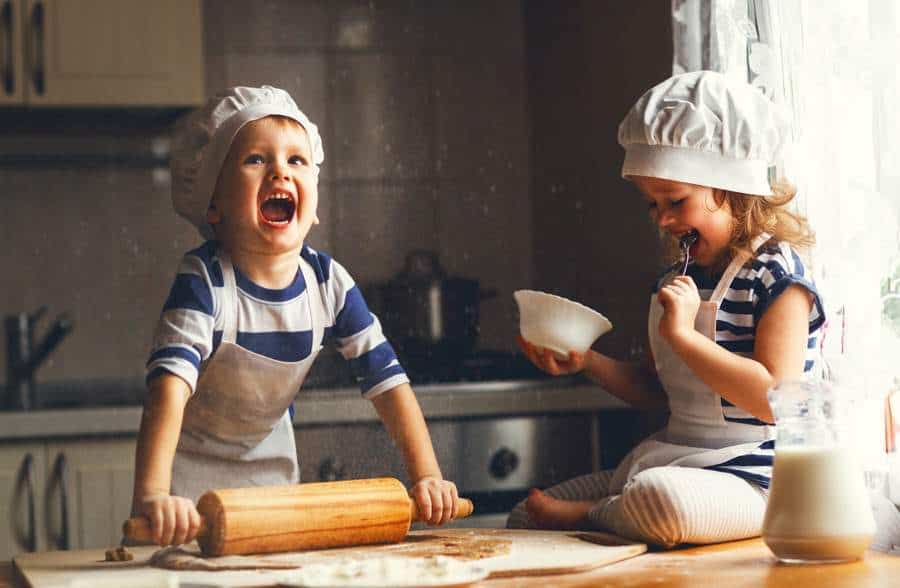Family Fun – in the Kitchen?

Kids love cooking! But we still often choose not to involve them.
It can take longer, be messier and be hard to enjoy. But including children in the cooking process has heaps of benefits too.
In fact, getting your children involved in the kitchen may be one of the best things you can do for them—and for your relationship with them.
Studies show that working with family members to prepare meals benefits children in many ways. Learning to prepare their own food helps to build confidence. And it helps the child to start making his or her own healthy choices about what to eat and become more adventurous about trying new and healthy foods.
Cooking with your child can also strengthen the bond between you and encourage communication, around a fun and natural activity.
How young is too young?
The fact is that children start to show interest in helping in the kitchen already when they are very young, and possibly before you can think of tasks to give them to do! Many children will be curious about helping out already as young as two or three and it doesn’t have to be too young to involve them. In fact, they’ll benefit enormously from taking part and will enjoy even the smallest tasks.
Young children feel curious to learn and try new things – and at this stage, just about anything is new.
A very young child can snap the ends from green beans, crumble bread for bread crumbs, peel garlic, wash vegetables, learn to measure ingredients and roll out dough or stir mixtures with a spoon…
Think about the tasks you can give your child as you sense his or her interest growing. And perhaps try to let go of some of your ideas about what the child can or cannot do.
Just being involved is important for young children. As they grow older, they can learn to take on more difficult tasks like cracking eggs, cutting vegetables, operating appliances, and following a recipe on their own.
When they’re very young, just having a bowl and a spoon and a few ingredients to mix together can be a fun and enjoyable activity. And can give you the space you need to prepare other parts of the meal with less stress too.
Sharing memorable moments
Cooking may seem like a chore at times. We can feel short of time or tired at the end of the day and feel that we need to rush it before another need has to be attended to.
However, when we include the children in the cooking process, the activity can become a chance to spend quality time together as opposed to being a chore that needs to be completed as fast as possible. The attention on each other and closeness you can feel around sharing a task is great for heart-to-heart conversations or simply a chance to have a bit of fun together and it’s a great way to build strong family bonds.
It’s even sometimes easier to raise difficult of serious topics when you are busy working on a manual task and working alongside each other as opposed to facing each other.
But just as importantly, simply laughing, chatting, singing together or enjoying shared excitement about eating something we like the look of, can be the perfect antidote to stressful times at school, work, issues with friends or perhaps difficult moments in life.
Where to get started
The best place to start is with really simple recipes that will allow your child to enjoy successes right from the start. The simpler the better to avoid overwhelm or discouraging experiences. There are tons of great children’s recipe books and the best ones to start with have step by step instructions and lots of illustrations. Don’t forget that many children will feel very unfamiliar with even the most common ingredients and you want to make it easy for them so they can be autonomous for at least parts of the process.
Don’t make a big fuss about spills or imperfections, at this stage it’s more about becoming familiar with the foods and ingredients and you’ll be amazed at how fast they learn and improve. And you’ll be touched by the pride they’ll project when they see the results of their work. Make sure to encourage and complement them on jobs well done and teach them how to take part in the cleaning up, as well as the cooking.
You’re the child’s guide in the kitchen as they learn but you may be surprised at just how fast they pick up the new skills and become independent if they enjoy it. Many children soon want to experiment further with own recipes or discover new ways of combining ingredients and flavours and this is a wonderful way to get them to eat a great variety of food and be willing to experiment and try new things.
With encouragement, patience, and room to experiment and make mistakes, children learn to complete even complex tasks and enjoy the results. They learn when to go by the rules and when to break them in a safe environment.
And they learn the pride of accomplishment and the joy of giving to others.
Eat your greens
Children who help with cooking eat more vegetables! They feel more comfortable with trying new things, they are more likely to enjoy a greater variety of food and they are generally more ready to try new things if they have helped to prepare them.
Giving children the chance to learn about the food they eat and make their own choices and be involved in the preparation makes them naturally keen to also taste and enjoy the food. The pride they feel about their accomplishments is perfect for building an appetite to try more different food and ingredients over time.
To really build on this, make sure to involve your child in the decision process too. Let them decide what to cook and involve them when shopping for ingredients. Make it a part of the discovery process and encourage them to try new ingredients and foods. Who knows, maybe someday they’ll even want to try cooking ingredients they didn’t use to like.
Familiarity can create comfort and desire to discover. Just make sure to keep it fun. And don’t insist on a healthy ingredient they really don’t like. Instead look for other healthy alternatives and focus on including those. There are usually many possible healthy ingredients to choose from so variety should not be an issue even if there is some pickiness. And children tend to grow with what they’re exposed to so keep it fresh, fun, new and varied.
The extra time is an investment in your child’s future!
Cooking truly is a life skill and one of the most important ones that we can grow. Anything you teach your children in the kitchen will benefit them for the rest of their lives. Whether this is cooking skills, menu planning, basic kitchen hygiene or openness to trying new healthy options, they will take these skills into adulthood and continue to develop and use them.
You may feel that cooking with your children is time consuming and requires more patience than you have. And it’s true that we can often complete the same tasks in less time and making less mess on our own than if we include the children. But passing on involving the children in the kitchen also means that we miss out on the many benefits it can bring and is important to keep in the calculation.
Make it a regular event
If you want to make cooking with your children a regular activity, choose a day of the week that’s your cooking day. Make it a regular activity that’s in the diary – ideally on a day without after school activities or too much home work. You should expect to need more time for this at first, until your children get more used to cooking and will be faster and more independent.
And then choose what to cook. If you have a good children’s cookbook, let your child have a look and pick some recipes they like the look of. Agree on a first recipe, do the shopping (ideally together) and get started!
Start with this super simple but delicious recipe:
MEATBALLS IN TOMATO SAUCE
Recipe adapted from Usborne’s Beginner’s Cookbook (a great starter book for younger cooks)
16 meatballs/ Serves 4:
500g minced lean beef
2 level teaspoons of dried herbs
1 egg
1 tablespoon of flour
Olive oil or butter for cooking
You’ll also need pasta and to either buy or make your own tomato sauce using 1 onion, 1 clove of garlic and 400 g of chopped tomatoes, basil and tomato purée
How to prepare:
- Wash your hands well
- Break up the meat in a bowl. Add the egg as well as mixed herbs and flour
- With clean hands, pick up some of the mixture and shape it into a ball about the size of a tennis table ball. Try to make 16 balls using all of the mixture
- Heat three tablespoons of oil or butter in a frying pan and add eight meatballs. Keep the heat ‘medium high’ so the meat will cook but not burn. Turn the meatballs often until they are brown all over
- Put a paper towel onto a plate and lift the meat balls onto this once browned and cooked. Brown the other meatballs and put them on the plate when done.
- Make the tomato sauce by frying the onion and garlic in oil until soft. Then add all the other ingredients and leave it to cook for about 10 minutes (or use a good ready made sauce)
- Add the meatballs to the tomato sauce, put a lid on the pan and cook gently for 20 minutes, stirring occasionally
- Cook the pasta according to instructions on the packet
- Serve the pasta with the tomato and meatball sauce and enjoy!
Enjoy getting your child involved in making these, and play around with the ingredients to suit your family’s preferences!
Dorte is a healthy lifestyle coach who works with women and men who want to live better, happier and healthier lives. She teaches nutrition, health, mind-set and habit building and helps her clients feel slimmer, fitter, better, younger, happier and more fulfilled. She delivers her signature programmes the Feel Fab Formula and Lighter Living online and in various locations in the Geneva area. Find her on: Do***@****-v.com, www.soul-v.com and www.Facebook.com/groups/FeelFabLab
More from International School Parent
Find more articles like this here: www.internationalschoolparent.com/articles/
Want to write for us? If so, you can submit an article here: www.internationalschoolparent.submittable.com
